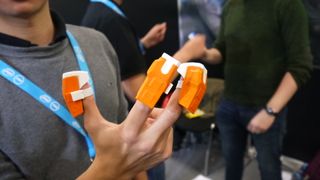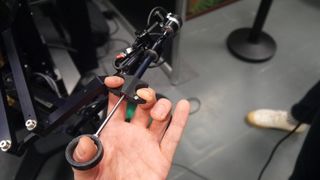Meet three inventions ushering in the next generation of VR
There's no looking back

What’s next for VR? Now that the three main headsets are available to buy, you’d be forgiven for thinking that the hardware is more or less finished, and that now the challenge is now making enough software to get people to spend big on the headsets themselves.
But after seeing and trying out three new VR-focussed inventions, it's obvious that there’s a lot of potential left in the hardware that’s yet to be explored.
From full-body tracking to haptic feedback, VR's nagging issues are proving a hard nut to crack, but these companies are determined to make the tech work.
VR Touch
VR Touch is a deliciously simple invention that has the potential to help remove the need for handheld controllers entirely.
At its core, it’s a small haptic feedback motor which you attach to the end of your finger that simulates the sensation of touching things in VR. Move your finger close to a virtual button and you'll feel a motor pushing on your finger as though you’re pushing on a real button.
The invention’s creator, Go Touch VR, is currently working with HTC to allow its Vive’s base stations to track the location of your hands. But, for now, motion tracking is handled principally by a Leap Motion sensor that’s attached to the front of the headset. The motor itself contains an additional gyroscope for more approximate tracking when your hands are out of sight of the sensor.

We tried the system with a single motor attached to the index finger on our dominant hand, but up to five devices can be used for a full hand experience.
Get daily insight, inspiration and deals in your inbox
Get the hottest deals available in your inbox plus news, reviews, opinion, analysis and more from the TechRadar team.
The system is simple, but effective. Reach out to touch something, and the pressure on your finger gradually increases as your finger touches it. Interestingly, although there’s nothing there in real life you’ll find that the pressure makes your brain unconsciously try to stop your fingers from moving through the virtual object.
Of course, if you consciously tell your hand to do so, then your fingers will still pass straight through it. If you’re looking for something with a little more resistance (and a much higher price tag), then you’ll want to check out this next gadget.
Toia
Whereas VR Touch is an invention that focuses on making force feedback affordable rather than making it perfect, Toia is attempting the opposite, and the result is a surprisingly capable haptic experience.
It’s not the easiest system to get set up with. A device the size of a typewriter sits on a desk, and you then strap your fingers into individual harnesses which are attached to the motor via metal arms. The system we used supported up to two fingers, but we were told that the full kit can support many more.
It’s a pain to set up, and the device is bulky and immobile, but once you’re strapped in Toia manages to make you feel as though you’re interacting with real, physical items, in a completely virtual space.

The large motors push back against your fingers as soon as they touch an object in the virtual space, allowing them to do anything from resting on a virtual tabletop to picking up objects with real weight to them with two fingers in the system.
Because of its size, complexity and presumed cost, the team are currently targeting professional use cases. Another demo station had a controller the shape of a syringe to allow dentistry students to be taught how to correctly inject a needle into a patient’s mouth.

We tried it out and the effect was surreal. Once the syringe was inserted into our virtual patient, it’s range of motion reduced considerably, and we felt real resistance as we pushed it further. If you’re afraid of needles, then you might want to give this one a miss.
In its current form the system is very limited. The thick metal bars that are attached to each of your fingers mean that the movement of your hand is restricted (you can’t even turn it over, for example), and the motors weren’t quite strong enough to stop our fingers completely, leading to every virtual object having a squishy, rubbery feel rather than the hardness of metal or wood.

Shogun
If the other technologies on this list feel a little small scale, then Shogun might be of more interest.
The system, developed by Vicon Software, will look familiar to anyone who’s ever watched a behind-the-scenes documentary about motion capture in video-games or movies.
Covering an actor in little silver balls and having them look ridiculous is nothing new, but Shogun is able to take this data and, in real-time, apply it to a 3D model that wouldn’t look out of place in a modern console game.

Combining this with virtual reality means not just being able to see the precise location of someone’s hands and head, but every limb of their body.
Playing a game with someone over the internet could immediately feel like being in the same room as them, or the system could even track three players in the same space to allow them to see, and hence avoid, one another. With Nvidia currently showing off the potential for multiple Vives running off a single PC, this might be something that’s needed sooner rather than later.
Although the system currently requires you to get fully kitted up with a skin-tight motion-capture suit, Vicon is hoping that in the future they’ll be able to attach a couple of silver tracking pads to the outside of people’s clothes to make the whole process simpler.
The hardware's far from done
If these three inventions have shown us anything, it’s that there’s still so much more work that needs to be done on the hardware side of virtual reality before our Holodeck-equipped future is finally here.
The VR games might be getting better than ever, but it’s only once you’ve felt a virtual snooker ball push back against your fingers, or seen a fully-rendered torso in virtual reality, that you realize how weightless a lot of VR experiences currently feel.
These prototypes might be early, but already have us excited about the next generation of VR.
Jon Porter is the ex-Home Technology Writer for TechRadar. He has also previously written for Practical Photoshop, Trusted Reviews, Inside Higher Ed, Al Bawaba, Gizmodo UK, Genetic Literacy Project, Via Satellite, Real Homes and Plant Services Magazine, and you can now find him writing for The Verge.

